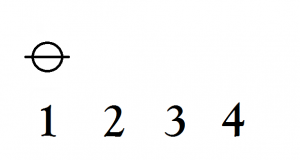Whole Notes and Rests
Counting whole notes and rests isn’t too hard; they are both worth 4 beats each.
Things to remember:
A note makes sound
A rest is silent
Let’s try an example:
If we count that whole note out loud it would sound like this:
“onnnnnnneeeeeee”
Video Player
00:00
00:00
Did you notice that I didn’t count beats “two” “three” and “four” out loud? Why?
Because the whole note lasts for 4 full beats, which means the sound it makes carries through beats “two” “three” and “four.”
Let’s try an example with more than one measure:
If we count that rhythm out loud it would sound like this:
“onnnee three four onnnnnnneeeeeee” Video Player
00:00
00:00
Did you notice that I didn’t count beat “two” in the first measure or beats “two” “three” and “four” in the second measure? Why?
Because the half note is worth two beats, so the sound it makes carries through beat “two”, and the whole note is worth 4 beats, so the sound it makes carries through beats “two” “three” and “four.”
You treat whole rests the same way you would the whole notes:
If we count that rhythm out loud it would sound like this:
“one two three four “Video Player
00:00
00:00
Did you notice that the entire second measure was silent? Why?
Because the whole rest is silent for 4 beats.
Also, did you notice that the whole rest was in the middle of the measure instead of being directly over a number? When you use a whole rest, it means the entire measure is silents, so you put it in the middle to make it easier to read, and to look nice on the page.


